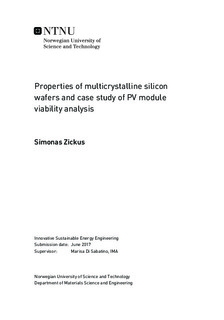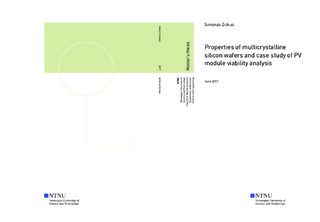| dc.description.abstract | Multicrystalline silicon solar cells are becoming a major stream technology. The main reason is the increase of efficiency of solar cells and constant production costs decline. In some countries PV can directly compete with conventional energy generation methods, but in most incentives are still needed. In this project properties of multicrystalline silicon wafer are described and the relevant experiments are performed. Results show that grain boundary structure is not dependent on the industrial processes, while dislocation density showed a minor improvement. The highest lifetime of wafer minority carriers is observed in the middle of the ingot, while the bottom suffered from the high impurity count. Gettering in most of the ingot had a negative effect on lifetime, but combined with hydrogenation, it out-performed the as-cut case. In addition, simulation of solar power plant was performed for Lithuania, Norway, Germany, Greece, India, China, USA and UAE countries. The main objective was to determine if solar power can compete with conventional electricity generation source, without incentives or feed-in tariffs. Simulation results revealed that Greece and Germany are the best place for solar power generation in private house sector, while Norway and UAE performed the worst. | |

